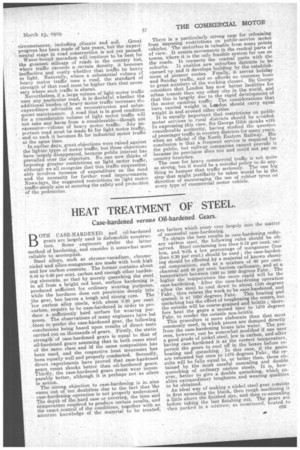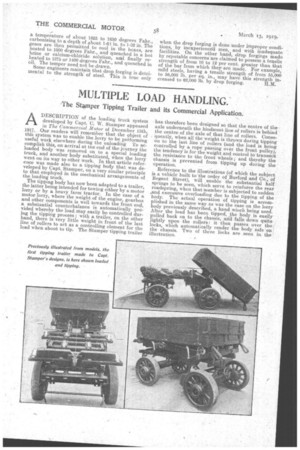HEAT TREATMENT OF STEEL.
Page 13

Page 14

If you've noticed an error in this article please click here to report it so we can fix it.
Case-hardened versus Oil-hardened Gears.
BOTH CASE-HARDENED and oil-hardened gears are largely used in iiutomobile construction. Some engineers pfefer the latter method of hardening, and consider it somewhat more reliable to accomplish.
Steel alloys, such as chrome-vanadium, chromenickel and silico-manganese are made with both high and low carbon contents. The former contains about 0.45 to 0.60 per cent, carbon and enough other hardening elements, so that by merely quenching the steel in oil from a. bright red heat, surface hardening is produced sufficient for ordinary wearing purposes, while the hardness does not penetrate deeply into the gear, but leaves a tough and strong core. The low carbon alloy steels, with about 0.20 per cent. carbon, require to be case-hardened in order to produce a sufficiently hard surface for wearing purposes. The observations of many engineers have ledthem to prefer the case-hardened gear, the following conclusions being based upon results of direct tests carried out on thousands of gears. Firstly, the static strength of case-hardened gears is equal to that of oil-hardened gears assuming that in both eases steel of the same class and of the same composition has been used, and the respective heat treatment has been equally well and properly conducted. Secondly, direct experiments have proved that case-hardened gears resist shocks better than oil-hardened gears. Thirdly, the case-hardened gears resist wear incomparably better, although it is perhaps not as silent
in action. .
The strong objection to case-hardening is in. nine eases out of ten doubtless due to the fact that the case-hardening operation is not properly understood. The depth of the hard ease or covering, the time and temperature reqUired to produce certain results, and the exact control of the conditions, together with an accurate knowledge of the material to be treated, are factors which enter very largely into the matter of successful case-hardening. To obtain the best results in case-hardening ordinary carbon steel, the following rules should be observed. Steel containing less than 0.12 per cent, car
bon, and with a low percentage of manganese (less than 0.30 per cent.) should be used ; the case-hardening should be effected by a material of known chemical composition; such as a mixture of 60 per cent. charcoal and 40 per cent, barium carbonate, and at a temperature between 1560 to 1920 degrees Fahr. The higher the temperature the more rapid will be the case-hardening.' After the case-hardening operation alloW the steel to cool downto about 1100 degrees Fahr., then reheat the work to be case-hardened, and quench it at 1650 degrees Fahr. This heating and quenching has the effect of toughening the centre, but the outside will be coarse-grained and brittle ; therefore heat the gears a second time to 1470 degrees Fahr. to render the outside non-brittle.
This procedure is more elaborate than that most
commonly used, in which pieces are dumped directly from the case-hardening boxes into water. The process, however, can be somewhat modified if one uses a good grade of nickel steel, low in carbon, and after having case-hardened it at the correct temperature, permit the gears to cool off in the boxes before reheating and quenching. In this case, if the gears are reheated but once to 1470 degrees Fahr., the results will be fully equal to, or better than, tkose obtained by the most careful annealing and double quenching of -ordinary carbon steels. It is, however, better to give a double quenching, which enables extraordinary toughness and wearing qualities , to be obtained.
An ideal way of making a nickel steel gear consists in first annealing the blank, then rough machining it a little above the finished size, and then re-annealing beforetaking the last finishing cut. The gears arc
i then packed n a mixture, as mentioned, heated to
a temperature of about 1625 to 1650 degrees Fahr., carbonizing to a depth of about 1-61 in. to 1-32 in. The gears are then permitted to cool in the boxes, are heated to 1500 degrees Fahr., and quenched in a hot brine or •calcium-chldride solution, and finally reheated to 1375 or 1400 degrees Fahr., and quenched in oil. The temper need not be drawn.
Some engineers maintain that drop forging is detrimental to the strength' of steel. This is true only
when the drop forging is done under improper conditions, by inexperienc‘d men and with inadequate facilities. On the other hand, eltop forgings made by reputable concerns'are claimed to possess a tensile strength of from 10 to 12 per cent, greater than that of the bar from which they, are made. For example, mild steels, having a tensile strength of from 55,000 to 58,000 lb., per sq. in., may have this strength in
creased to 62,000 lb. by drop forging. H. M.






















